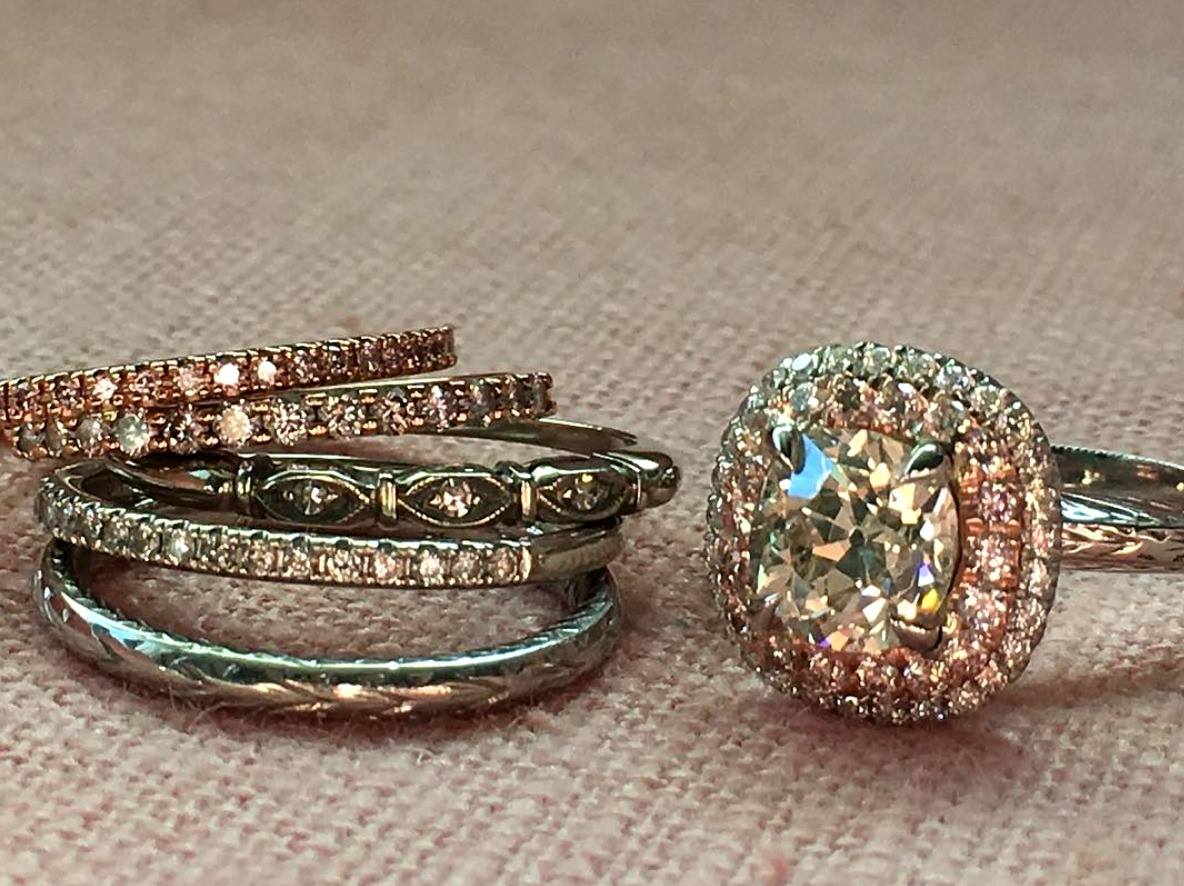R.H. Custom Bezel Sapphire and Diamond Ring

Understanding a ring’s anatomy is critical when deciding on an engagement ring. And while most focus on the size and cut of the gem, let’s us not forget the power of the prong!
Different ring designs demand different numbers of prongs. As you might guess, less prongs means less of the gem is covered meaning more access to light and more sparkle.
Four prongs create more a clean, linear and often square look whereas six prongs tend to showcase a rounded shape of a gem more effectively. Too many prongs can overwhelm a smaller gem and too few prongs can leave to an unsafe setting for your ring (something you definitely don’t want!).
Want a less visible look to the prongs on your engagement ring? Consider using white metal which not only highlights the metal but makes the gem appear larger (something you definitely do want!).
Here are a few examples of smartly placed prongs:
Move over, big and bulky statement necklace. Here comes the classic pendant necklace that works perfectly with just about any outfit.
So what is it about a statement necklace that makes it such a fashionably smart choice?
Good things come in small packages. While statement necklaces love to grab attention, pendant necklaces have a subtler eye-catching effect that gently enhance your fashion du jour.
Create your signature pendant. A good pendant necklace is almost as personal as a wedding ring. It highlights your feminine side with pride. Choose a pendant that truly represents your personality and wear it daily with pride!
Easy to layer. Layering necklaces is all the rage so dare to pair your pendant necklace with other necklaces. (Just make sure the length is varied enough that no necklace is “buried” by another.)
Why not have your own pendant necklace custom designed so you can create your own statement? We take the time to get to know every customer personally, ensuring that each piece fully and genuinely represents you.

We love the stackable ring trends…but we’ve seen it done incorrectly where the balance and symmetry isn’t quite right. So is there a “rule” to stacking rings?
First off, there’s no hard or fast rule to any fashion trend that can’t be adapted and changed. It’s important to take some chances and experiment for a while until you find a technique to creating a “finger party” that feels like a fit.
Here are a few pointers that you can try:
Mix metals. Don’t be afraid to mix metals when stacking. As a matter of fact, its the variety of shades and sizes that make for an inviting overall look.
Alternate power fingers. Go ahead and stack heavy on one finger…but go simple with the finger adjacent to it. (Commonly, the middle finger is a power finger.)
Don’t overdo. Coco Chanel once infamously said, “Before you leave the house, look in the mirror and take one thing off.” The same applies with ring stacking. It’s fun to go overboard when you first start but dare to remove one unnecessary stacker before you finish.
Think balance. According to a recent Forbes article: “The one rule is balance, so pay attention to your fingers’ Feng Shui! I personally wear a stack of four or five similar thin rings on my first finger, a tall yet simple shape on my middle finger, and then a short stack of two different-sized rings on my ring finger. That way I have near-uniform ring-height across my hand but the total look isn’t overwhelming.” —Catherine Alexander, Founder and Designer of Stanmore.
Hi Jen. I left you a voicemail but wanted to send you a note also. My ring was delivered this morning. My hands were shaking as I opened the package. When I saw the ring and then tried it on I started crying. It is STUNNING and exactly what I wanted! Thank you so much Jen for all of the time and effort you put in to this. I appreciate it more than you know. I also want to thank you for making arrangements for me to get it today. . . . Thank you for making sure I got it before I have to leave. . . . . Again, thank you for everything. Sincerely,
D. W.
The process of cutting and polishing gems is called gem-cutting (or lapidary). Gems are cut and polished by progressive abrasion using finer and finer grits of harder substances.
Above is an example of how cutting affects a gemstone’s appearance. These are 3.5mm yellow sapphires prior to going into a bracelet. Stone #1, in addition to having better proportions, has a flower, or star pattern at the base/culet of the stone. The result is a much brighter looking stone.
When it comes to gem-cutting, every facet counts. Let us take your custom design jewelry to the next level with our lapidary expertise.